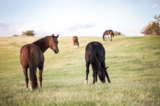
Students will learn about the difference in horse colors, leg makrings and face markings.
- Subject:
- Agriculture
- Material Type:
- Activity/Lab
- Author:
- Nicole Sorensen
- Date Added:
- 08/01/2023

Students will learn about the difference in horse colors, leg makrings and face markings.
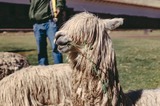
This lesson includes lectures discussing raising animals like llama, bison, alpaca, ratites, and an activity researching and planning a profitable business in the exotic breeds industry. Resource originally from New Mexico Animal, Plant, and Soil Science Lesson Plan Library.
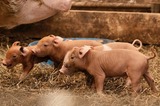
This lesson explores the swine industry: locating major physical characteristics, describing common breeds, selection of superior animals, and contrasting production systems and marketing methods of swine and hogs. Adapted from New Mexico Animal, Plant, and Science Lesson Plan Library.
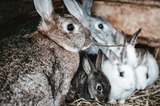
Overview: A dozen Nebraska Ag teachers contribute to a thread asking about all aspects of successful livestock labs in other towns. They discuss town/city relationship and regulations, animals, enclosures, unforeseen successes and speed bumps, etc.

This resource is a video abstract of a research paper created by Research Square on behalf of its authors. It provides a synopsis that's easy to understand, and can be used to introduce the topics it covers to students, researchers, and the general public. The video's transcript is also provided in full, with a portion provided below for preview:
"Diarrhea is common among calves and causes huge losses to the global cattle industry. Fecal microbiota transplantation (FMT) is one promising approach to prevent and treat calf diarrhea. However, achieving success with FMT is difficult because of farm management differences, a lack of good donors, and the difficulty of recipient selection. To guide more effective FMT, a recent study investigated factors related to FMT success or failure in 20 donor–recipient pairs. The overall success rate for diarrhea improvement was 70%. Selenomonas bacteria were found in both donors and recipients when FMT was successful, suggesting that Selenomonas may be a biomarker of donor–recipient compatibility, and Sporobacter was identified as a potential biomarker for good donor selection. Pairs of correlations between specific microbial taxa and metabolites were also linked to success, and low levels of pre-FMT glycerol 3-phosphate, dihydroxyacetone phosphate, and isoamylamine were predicted to facilitate good results..."
The rest of the transcript, along with a link to the research itself, is available on the resource itself.
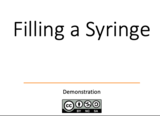
In this lesson, students will watch a video/teacher demonstration on how to properly fill a syringe. The students will mime the procedure while the teacher reviews the procedures. Students will also practice with a syringe, needle, and sterile water bottle. Once the students are comfortable with the procedures, they will make a recording of their demonstration to be submitted for grading.NE.AFNR.HS.28.5.b or NE.AFNR.HS.29.5.b
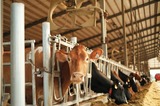
This lesson offers an understanding of the historic and economic implications of the livestock industry to our state and nation. Learners will recognize the best management practices for specific food animal species, as well as identify the important breeds of each species. This represents a portion of the Introduction to Agriculture, Food, and Natural Resources (AFNR) series in Nebraska middle and high school agricultural education.

In this lesson, students will view a "yuck steak" and identify that the lesion is caused by an injection. Students will then watch videos on how to administer an intramuscular and subcutaneous injection. After watching the videos, the student will use the Marcel Marceau e-Moment to mime the procedures. The students will then practice injections on an orange and cut the orange in half, viewing how the injections disperse throughout the orange. The students will then video their demonstrations of each injection to submit for grading.NE.AFNR.HS.28.5.b or NE.AFNR.HS.29.5.b

This resource is a video abstract of a research paper created by Research Square on behalf of its authors. It provides a synopsis that's easy to understand, and can be used to introduce the topics it covers to students, researchers, and the general public. The video's transcript is also provided in full, with a portion provided below for preview:
"Laying hens are predominantly kept in small battery cages. These cages are so small, in fact, that the birds usually cannot extend their wings or exhibit other natural behaviors like foraging and nesting. Public criticism of this practice is driving egg producers to change to higher welfare cage-free aviaries. But there have been some claims that cage-free systems could have higher mortality rates than battery cages. A recent meta-analysis used data from 6,040 commercial flocks – 176 million birds – spanning 16 countries to investigate this claim. They found that, while mortality in cage-free flocks was higher in the past, it decreased over time. In fact, data from recent years shows no difference in mortality between caged and cage-free systems. The decrease in mortality likely reflects an increase in flock managers' experience. More research is needed into causes of death in different egg production systems..."
The rest of the transcript, along with a link to the research itself, is available on the resource itself.
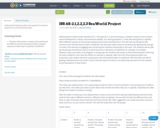
Indiana State Standards AS-2.1 through AS-2.3 research project for our Second Grade Class.

In this lesson, students will be asked to determine what is wrong with a patient that is displaying symptoms of rabies. Then the students will be asked what causes sickness in animals. Then they will research the causes of illness and disease in animals with the Go Get It e-Moment. A discussion about how to prevent illness and disease will lead to an understanding of biosecurity. The students will then use what they have learned to complete a health plan for an animal in their lives.NE.AFNR.HS.28.5.a or NE.AFNR.HS.29.3.b
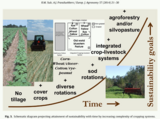
This presentation is an introductory lesson on integration of crop-livestock systems in the United States. The lesson includes national Agriculture, Food, and Natural Resources Standards, objectives, and a student project. This lesson is intended to be inquiry-based, and as such only foundational information is presented. Students are expected to take the introductory information and find specific information needed to solve the problem posed at the beginning of the presentation. It is expected that at a minimum this lesson will take three 50-minute class periods and could take longer based on teacher preferences.

Students will analyze animals against a standard ideal, and explain the relationship between an animal’s form and function.
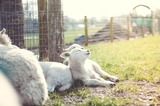
Students will be able to use correct terminology for livestock (e.g. bovine, steer, ewe, ram). This lesson is used in exploring agriculture, animal science lesson. Written by Kathryn Savat.

This lesson plan explores the difference between good and poor quality feedstuffs by learning the functions of feed, identifying feed types and characteristics, and identifying how animals are fed. Lesson plan from the New Mexico Animal, Plant, and Soil Science Lesson Plan Library.
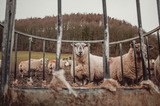
This lesson includes lectures about meeting the nutritional needs of animals to maintain animal performance, analyze feedstuffs for quality, and determine whether or not a feed ration fulfills a given animal’s nutrient requirements. From New Mexico Animal, Plant, and Soil Science Lesson Plan Library.

This resource is a video abstract of a research paper created by Research Square on behalf of its authors. It provides a synopsis that's easy to understand, and can be used to introduce the topics it covers to students, researchers, and the general public. The video's transcript is also provided in full, with a portion provided below for preview:
"Every year, billions of male chickens are killed in hatcheries around the world. But a new imaging technique may be changing these culling practices by making it possible to determine the sex of chicks before they hatch. In the poultry industry, male chickens are of little economic value. They don’t lay eggs and they are not suitable for meat production. Because of this, day-old male chicks are culled, typically by asphyxiation or grinding. To find an alternative to this unfortunate practice, a team of researchers working in Germany investigated whether in-egg optical spectroscopic techniques could be used to determine the sex of developing chickens. Creating a small window in the egg’s shell, the researchers used a near-infrared laser to illuminate blood vessels outside the embryo and analyzed fluorescence signals obtained directly from the blood cells..."
The rest of the transcript, along with a link to the research itself, is available on the resource itself.
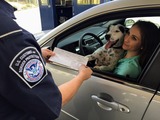
This activity is a web-based inquiry on how to control the spread of rabies in a community. Students are given a hypothetical situation in which rabies has been found in their home community. Interaction between the people, pets, wildlife, and livestock in the area is emphasized. An informative lesson on rabies is included. Students are asked to use different resources to research and develop an action plan to stop the spread of rabies in their community.
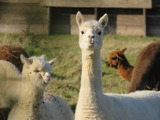
This lecture with slides introduces the functions of ruminant animals, parts and processes of the ruminant digestive system, and details the first two components of the digestive system of ruminant animals. Created by: Arelene Barrett, Dennis Bratton, Mariah Gumphry, Haley Vrazel
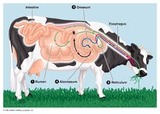
This lesson presents students with information regarding the differences between ruminant and monogastric digestive systems. The project portion of this lesson allows students to work in small groups and get creative to demonstrate their knowledge of these two digestive systems.